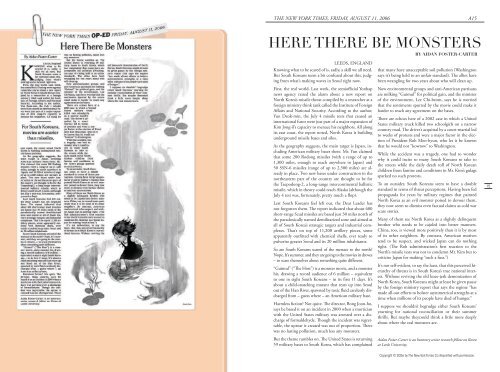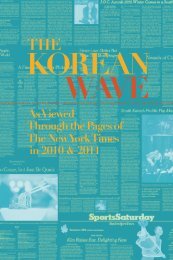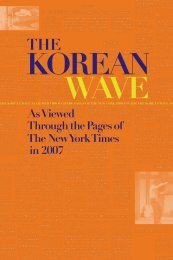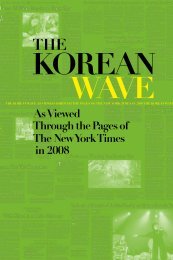The Korean Wave 2006 - Korean Cultural Service
The Korean Wave 2006 - Korean Cultural Service
The Korean Wave 2006 - Korean Cultural Service
You also want an ePaper? Increase the reach of your titles
YUMPU automatically turns print PDFs into web optimized ePapers that Google loves.
<strong>The</strong> New York Times, Friday, August 11, <strong>2006</strong><br />
a15<br />
Here <strong>The</strong>re Be Monsters<br />
By AIDAN FOSTER-CARTER<br />
LEEDS, ENGLAND<br />
Knowing what to be scared of is, sadly, a skill we all need.<br />
But South <strong>Korean</strong>s seem a bit confused about this, judging<br />
from what’s making waves in Seoul right now.<br />
First, the real world. Last week, the semiofficial Yonhap<br />
news agency raised the alarm about a new report on<br />
North Korea’s missile threat compiled by a researcher at a<br />
foreign ministry think tank called the Institute of Foreign<br />
Affairs and National Security. According to the author,<br />
Yun Deok-min, the July 4 missile tests that caused an<br />
international furor were just part of a major expansion of<br />
Kim Jong-il’s capacity to menace his neighbors. All along<br />
its east coast, the report noted, North Korea is building<br />
underground missile bases and silos.<br />
As the geography suggests, the main target is Japan, including<br />
American military bases there. Mr. Yun claimed<br />
that some 200 Rodong missiles (with a range of up to<br />
1,300 miles, enough to reach anywhere in Japan) and<br />
50 SSN-6 missiles (range of up to 2,500 miles) are already<br />
in place. Two new bases under construction in the<br />
northeastern part of the country are thought to be for<br />
the Taepodong-2, a long-range intercontinental ballistic<br />
missile, which in theory could reach Alaska (although the<br />
July 4 test was, fortunately, pretty much a flop).<br />
Lest South <strong>Korean</strong>s feel left out, the Dear Leader has<br />
not forgotten them. <strong>The</strong> report indicated that about 600<br />
short-range Scud missiles are based just 30 miles north of<br />
the paradoxically named demilitarized zone and aimed at<br />
all of South Korea’s strategic targets and industrial complexes.<br />
That’s on top of 11,200 artillery pieces, some<br />
apparently outfitted with chemical shells, ever ready to<br />
pulverize greater Seoul and its 20 million inhabitants.<br />
So are South <strong>Korean</strong>s scared of the menace to the north?<br />
Nope. It’s summer, and they are going to the movies in droves<br />
– to scare themselves about something quite different.<br />
“Guimul” (“<strong>The</strong> Host”) is a monster movie, and a monster<br />
hit, drawing a record audience of 6 million – equivalent<br />
to one in eight South <strong>Korean</strong>s – in its first 11 days. It’s<br />
about a child-snatching mutant that rears up into Seoul<br />
out of the Han River, spawned by toxic fluid carelessly discharged<br />
from – guess where – an American military base.<br />
Harmless fiction? Not quite. <strong>The</strong> director, Bong Joon-ho,<br />
says he based it on an incident in 2000 when a mortician<br />
with the United States military was arrested over a discharge<br />
of formaldehyde. Though the incident was regrettable,<br />
the uproar it created was out of proportion. <strong>The</strong>re<br />
was no lasting pollution, much less any monsters.<br />
But the theme rumbles on. <strong>The</strong> United States is returning<br />
59 military bases to South Korea, which has complained<br />
that many have unacceptable soil pollution (Washington<br />
says it’s being held to an unfair standard). <strong>The</strong> allies have<br />
been wrangling for two years about who will clean up.<br />
Now environmental groups and anti-American partisans<br />
are milking “Guimul” for political gain, and the minister<br />
of the environment, Lee Chi-beom, says he is worried<br />
that the sentiments spurred by the movie could make it<br />
harder to reach any agreement on the bases.<br />
<strong>The</strong>re are echoes here of a 2002 case in which a United<br />
States military truck killed two schoolgirls on a narrow<br />
country road. <strong>The</strong> driver’s acquittal by a court-martial led<br />
to weeks of protests and were a major factor in the election<br />
of President Roh Moo-hyun, who let it be known<br />
that he would not “kowtow” to Washington.<br />
While the accident was a tragedy, one had to wonder<br />
why it could incite so many South <strong>Korean</strong>s to take to<br />
the streets while the daily death toll of North <strong>Korean</strong><br />
children from famine and conditions in Mr. Kim’s gulags<br />
sparked no such protests.<br />
To an outsider, South <strong>Korean</strong>s seem to have a double<br />
standard in terms of threat perceptions. Having been fed<br />
propaganda for years by military regimes that painted<br />
North Korea as an evil monster poised to devour them,<br />
they now seem to dismiss even factual claims as cold war<br />
scare stories.<br />
Many of them see North Korea as a slightly delinquent<br />
brother who needs to be cajoled into better manners.<br />
China, too, is viewed more positively than it is by most<br />
of its other neighbors. By contrast, American motives<br />
tend to be suspect, and wicked Japan can do nothing<br />
right. (<strong>The</strong> Roh administration’s first reaction to the<br />
North’s missile tests was not to condemn Mr. Kim but to<br />
criticize Japan for making “such a fuss.”)<br />
It’s not self-evident, to say the least, that this perceived hierarchy<br />
of threats is in South Korea’s true national interest.<br />
Without reviving the old knee-jerk demonization of<br />
North Korea, South <strong>Korean</strong>s might at least be given pause<br />
by the foreign ministry report that says the regime “has<br />
made all-out efforts to bolster asymmetrical strengths at a<br />
time when millions of its people have died of hunger.”<br />
I suppose we shouldn’t begrudge either South <strong>Korean</strong>s’<br />
yearning for national reconciliation or their summer<br />
thrills. But maybe theycould think a little more deeply<br />
about where the real monsters are.<br />
Aidan Foster-Carter is an honorary senior research fellow on Korea<br />
at Leeds University.<br />
15<br />
Copyright © <strong>2006</strong> by <strong>The</strong> New York Times Co. Reprinted with permission.





